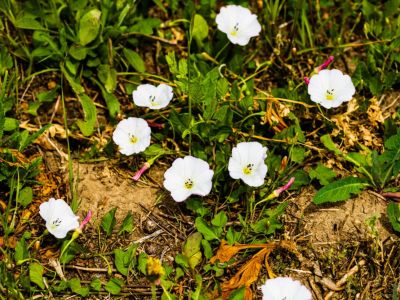Identifying Bindweed
Before you can get rid of bindweed, you need to make sure that the weed you have is bindweed. Bindweed (Convolvulus) is often called wild morning glory because it looks like morning glory. Bindweed is a climbing vine. Normally, the first signs that you have bindweed will be thin thread-like vines that wrap themselves tightly around plants or other upward objects. Eventually, the bindweed vines will grow leaves, which are shaped much like an arrowhead. After the leaves appear, the bindweed vine will start growing flowers. Bindweed flowers are trumpet-shaped and will be either white or pink.
How to Control Bindweed
Part of why it is so hard to get rid of bindweed is that it has a large and hardy root system. Single attempts to remove bindweed roots will not be successful. When controlling bindweed, the first thing to remember is that you will need to make several attempts of the bindweed control method you choose several times before you can successfully kill bindweed.
Organic and Chemical Approaches for Bindweed Control
Both boiling water (organic) and non-selective herbicides (chemical) can be used to get rid of bindweed. Both of these options can kill any plant where applied. These methods are ideal for areas where bindweed is growing but there are no other plants you wish to save. These would be areas like driveway cracks, empty vegetable beds, and vacant lots. To use boiling water to kill bindweed, simply boil some water and pour it on the bindweed. If possible, pour the boiling water about 2 to 3 feet (61-91 cm.) beyond where the bindweed is growing so that you can get as much of the roots as possible. If you are using an herbicide, apply it heavily to the bindweed plant and re-apply every time the plant reappears and reaches 12 inches (31 cm.) in length.
Repeated Pruning to Kill Bindweed
Another popular method for controlling bindweed is to prune the vines back to the ground repeatedly, whenever they appear. Take a pair of scissors or shears and snip the bindweed vine off at ground level. Watch the location carefully and cut the vine back again when it appears. This method forces the bindweed plant to use up its energy reservoirs in its roots, which will eventually kill it.
Controlling Bindweed with Aggressive Plantings
For as stubborn as bindweed can be, it has a very hard time competing with other aggressive plants. Often, bindweed can be found in poor soil where few other plants can grow. Improving the soil and adding plants that spread densely will force the bindweed out of the bed. If you have bindweed in your lawn, dethatch the lawn and apply fertilizer to help your lawn grow more compactly, which then makes it far more difficult for bindweed to grow. Note: Chemical control should only be used as a last resort, as organic approaches are more environmentally friendly.
